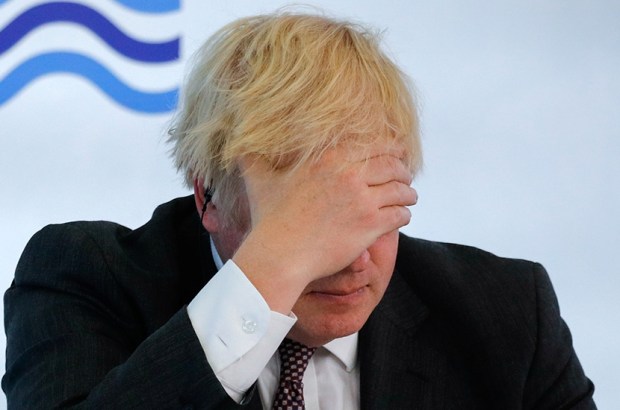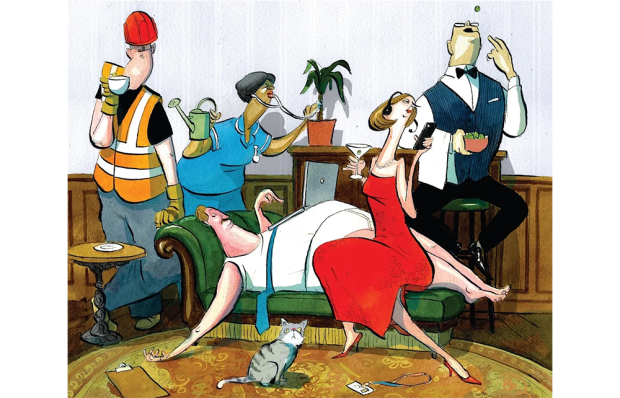‘Alas’ is a word used many times by Boris Johnson during the pandemic. It is how he prefaces announcements that the data is getting worse and so the government has to impose further restrictions. In recent weeks, though, the numbers have been going in the right direction. The first stage of the vaccination programme was completed two days ahead of schedule. For the first time in this crisis, government targets are being moved forward, not back. Early results seem to show that the jabs are more effective than expected: a Public Health Scotland study suggests that the Oxford-Astra-Zeneca vaccine, the workhorse of the UK immunisation programme, cuts the risk of hospitalisation by 94 per cent. At the same time, take-up has been higher than predicted.
Yet despite this, the government’s timetable for ending lockdown is very cautious. Rather than life being back to normal by Easter or the May Day bank holiday, we will have to wait until 17 May to drink inside a pub or eat indoors at a restaurant. The target date for the end of all restrictions on numbers is 21 June, the very last day of spring.
Tory MPs are, in general, rather disappointed by the pace of lockdown easing. They would have preferred a quicker timetable. But there is also relief that Johnson has explicitly ruled out going for a zero-Covid strategy and that there is an end date for all restrictions. A big fear on the Tory benches was that unless a date was set, restrictions could drag on for years in the way that rationing did after the second world war.
One senior Conservative backbencher from the more libertarian wing of the party observes that the plan ‘could have been worse’ and that there are ‘elements of a move in the right direction’. What he and other similarly minded Tory MPs would like is for the government to say it will move faster if the data continues to bring good news. ‘You say you are being driven by the data not dates, then you put dates in the document and say you won’t change them if the data changes,’ he complains. Some cabinet ministers are sympathetic to this argument. One tells me that ‘people want to see that there’s the flexibility to go faster if things are going well’.
Those on this side of the Tory argument think they will finally have public opinion on their side as spring progresses. They admit that they have been surprised by how tolerant the public have been of lockdown. But they also think that as the elderly and the vulnerable are vaccinated and the number of deaths begins to plummet, the public will want more of their liberties returned.
Interestingly, though, the government’s plan for easing restrictions prioritises social contact over the economy, which might enable it to maintain public support for longer. People will be able to host five friends in their own gardens a fortnight before they can drink in the garden of a pub. Last autumn’s attempt to limit ‘non-economic socialising’, which meant that in Tier 2 you could only see people from other households indoors if you went to a paying venue, has been scrapped in a recognition of the toll that the lockdown has taken on the ties that bind people together.
The problem for Tory libertarians is that they have very little leverage once the Commons has voted on the restrictions, which Johnson has said it will do before the Easter recess. These votes are expected to extend the Coronavirus Act for another six months and the emergency powers taken in January for the latest set of restrictions for a further three months. Once that has happened, MPs don’t have a mechanism to force an earlier reopening. (As one of their number admits, they would be unlikely to garner opposition support anyway — so their main weapon would be the size of the rebellion.)
For this reason, the easing of lockdown is likely to continue at the pace set out in the document. That said, despite the time-table repeatedly stating ‘no earlier than’, most Tory MPs are treating the dates as a target. Johnson himself appears to have done the same, saying that people would prefer certainty to haste. But if the data on vaccine take-up and efficacy continues to beat the government’s models, there will be some very impatient Tory MPs come June.
All being well, restrictions on numbers will go on 21 June. But that is not the full story. How normal life will feel after that depends on two reviews which will become the main focus of political debate from mid-May onwards. The first is on social distancing. This will determine whether measures such as the one-metre rule and the work-from-home guidance continue or not. If the one-metre rule remains in place, many pubs and restaurants won’t be able to operate at capacity and won’t survive. Equally, if the government continues to urge people to work from home after 21 June, city centres will begin to change for good. With fewer workers in offices, places that rely on the after-work trade will be badly hit.
The second thing that will determine how normal life feels is the use of ‘Covid status certification’. This is whether you might have to produce proof of vaccination or a negative test to do things in this country. Johnson is instinctively uncomfortable with the idea. But some such arrangement is increasingly seen as almost inevitable — how else could you reopen a nightclub safely? The view in Whitehall is that the government is unlikely to ban venues from using such schemes but will want them to use Covid testing rather than rely exclusively on so-called vaccine passports, which discriminate against those unable to have the jab for any reason.
If on 22 June the one-metre rule and the work-from-home guidance are dropped, the summer in Britain will feel fairly normal. Johnson will be able to claim that the country’s vaccination programme has brought the economy and society back. But if significant social distancing remains in place then, alas, proper normality will remain a long way off and Johnson’s parliamentary party may become yet more rebellious.
Got something to add? Join the discussion and comment below.
Get 10 issues for just $10
Subscribe to The Spectator Australia today for the next 10 magazine issues, plus full online access, for just $10.
You might disagree with half of it, but you’ll enjoy reading all of it. Try your first month for free, then just $2 a week for the remainder of your first year.















Comments
Don't miss out
Join the conversation with other Spectator Australia readers. Subscribe to leave a comment.
SUBSCRIBEAlready a subscriber? Log in